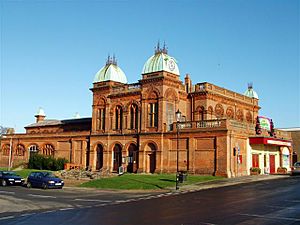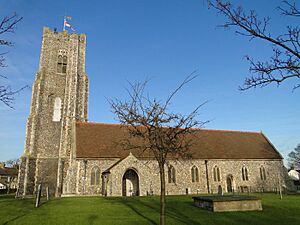Gorleston-on-Sea facts for kids
Quick facts for kids Gorleston-on-Sea |
|
|---|---|
| Town | |
 The Pavilion Theatre |
|
| Population | 24,470 (Built up area, 2021) |
| OS grid reference | TG520040 |
| District |
|
| Shire county | |
| Region | |
| Country | England |
| Sovereign state | United Kingdom |
| Post town | GREAT YARMOUTH |
| Postcode district | NR31 |
| Dialling code | 01493 |
| Police | Norfolk |
| Fire | Norfolk |
| Ambulance | East of England |
| EU Parliament | East of England |
| UK Parliament |
|
Gorleston-on-Sea, often just called Gorleston, is a fun seaside town in Norfolk, England. It's part of the borough of Great Yarmouth. You can find it south of Great Yarmouth, right across the River Yare.
Long ago, Gorleston was a busy port town in Suffolk. It was even mentioned in the Domesday Book, a famous survey from 1086. In 1836, it became part of Great Yarmouth. The town's port was once important for catching herring fish. People also used "salt pans" to make salt, which helped preserve the fish. Later, around the Edwardian era, fishing became less popular. Gorleston then changed into a lovely seaside resort, a place where people go for holidays by the sea.
Contents
History of Gorleston
The name 'Gorleston' first appeared in the Domesday Book in 1086. It was written as Gorlestuna. The name might mean "girls' town or settlement."
Historically, Gorleston was in Suffolk. In the Middle Ages, it had two main areas, like big estates. The old St Andrew's Church is still in the town. This church is linked to the Gorleston Psalter, a beautiful 14th-century book with amazing pictures. A part of Gorleston called Southtown grew as a suburb, facing Great Yarmouth across the River Yare.
Transport and Attractions
Gorleston Barracks were built in 1853. The town once had three railway stations: Gorleston-on-Sea, Gorleston North, and Gorleston Links. These stations closed between 1942 and 1970. Today, the closest train stations are in Lowestoft and Great Yarmouth.
Gorleston's main attraction is its sandy "Edwardian Beach." It has pretty seaside gardens and a pond for model boats. There's also the Pavilion Theatre near the pier. You can find many shops on High Street. The town also has its own golf club, a hospital, and a library. On Riverside Road, there's a lighthouse, a lifeboat station, and a coastwatch station. In 2023, Gorleston beach was voted the best in Britain by Tripadvisor reviewers. It was also ranked the 12th best in Europe!
St Peter the Apostle Roman Catholic Church, built in 1938–39, was the only complete building designed by the artist Eric Gill.
During the Great Storm of 1987, Gorleston-on-Sea had the highest wind speed recorded in the UK that day. The winds reached 122 miles per hour (196 km/h).
Gorleston-on-Sea has appeared in books and films. The novel Gorleston by Henry Sutton (1995) describes the town in detail. It's also featured in Philip Leslie's novels The History of Us (2009) and What Remains (2013). The Pier Hotel and beach were also important locations in Danny Boyle's 2019 film Yesterday.
How Gorleston Became Part of Great Yarmouth
Gorleston was an old parish in Suffolk. In 1668, Southtown became part of Great Yarmouth's borough. The rest of Gorleston was added to the Great Yarmouth area in 1832. From 1836, Gorleston was officially managed as part of Great Yarmouth. The borough of Great Yarmouth used to be in both Norfolk and Suffolk. But in 1891, it was placed entirely in Norfolk.
Gorleston continued to be a civil parish within Great Yarmouth until 1974. On April 1, 1974, the civil parish was removed.
Education in Gorleston
Gorleston has several primary schools for younger students. For older students, there are secondary schools like Cliff Park Ormiston Academy, Lynn Grove Academy, and Ormiston Venture Academy.
East Norfolk Sixth Form College is also in Gorleston. A "sixth form" college is where students go after secondary school to study for advanced exams before university. This college is very important in Norfolk and attracts students from many areas.
East Anglian School for Deaf and Blind Children
The East Anglian School for Deaf and Blind Children was founded in Gorleston in 1912. It stayed there until it closed in 1985. During World War II, the school moved to Wales for safety. The headmaster's house in Gorleston was badly damaged by bombs in 1941.
Notable People from Gorleston
Many interesting people have connections to Gorleston:
- William Adams (1864–1913) – A highly awarded lifesaver and swimming teacher.
- Georgie Aldous (born 1998) – A British social activist, model, and online influencer.
- Jessica-Jane Applegate (born 1996) – A Paralympic swimmer and gold medalist.
- Rowland Fisher (1885–1969) – A painter known for his seascapes.
- William Fleming (1865–1954) – A highly awarded lifeboatman.
- John Fuller, Baron Fuller (born 1968) – A British life peer who joined the House of Lords in 2024.
- Stanley Charles Fuller (1907–1988) – Norfolk's first Olympic Athlete, who competed in the 1932 Olympic Games.
- Paul Derek Gibbs (born 1972) – A former footballer.
- Peter Green (1946–2020) – An English blues rock guitarist and founder of Fleetwood Mac.
- Ralph Jones (1900–1944) – A Gorleston-born Australian soldier who received the George Cross for bravery.
- Maurice Kaufmann (1927–1997) – An actor on stage, film, and TV.
- Myleene Klass (born 1978) – A TV presenter, musician, and former member of the pop group Hear'Say.
- Gregg Lowe (born 1986) – An actor.
- George William Manby (1765–1854) – The inventor of a life-saving mortar for shipwrecks.
- Campbell Archibald Mellon (1876–1955) – A painter and founder of the Great Yarmouth and Gorleston Society of Artists.
- Sammy Morgan (born 1946) – A former professional footballer.
- Kate Norgate (1853–1935) – A famous historian and author.
- Kip Sabian (born 1992) – A professional wrestler.
- Peter Simpson (born 1945) – A former professional footballer for Arsenal F.C..
- Hannah Spearritt (born 1981) – An actress and former member of the pop group S Club 7.
- Henry Edward Sutton (born 1963) – A Senior Lecturer in Creative Writing and an award-winning crime novelist.
See also
 In Spanish: Gorleston-on-Sea para niños
In Spanish: Gorleston-on-Sea para niños



